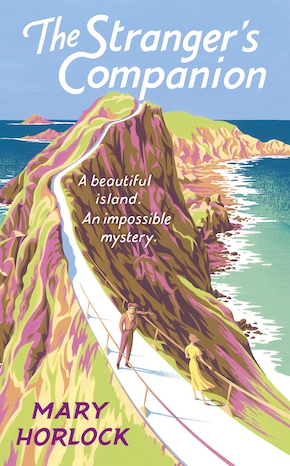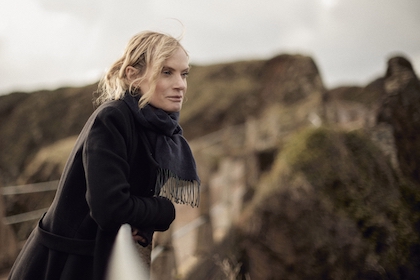Dark mysteries on Gothic shores
by Mary Horlock
I grew up on the island of Guernsey, in a house perched high on a cliff, and much as I’ve always loved the sea, I know to be afraid of it. I’ve watched how quickly a calm, clear morning can be swallowed by a storm, how a rogue wave or rip tide will catch you unawares. Of course shorelines are haunted, they are borderlands of uncertainty, at the edge what’s safe and known. My new novel The Stranger’s Companion is set on Sark, an island even smaller than my own, where to this day there are no cars or streetlights. As a time capsule it’s both magical and strange – a plateau of rock carved up by dirt tracks and crumbling paths and caves that disappear with the tides – and it was also the scene of a real-life mystery when, in October 1933, the clothes of a man and a woman were found neatly folded on the cliffs, their owners nowhere in sight. ‘Island Riddle’ ran the headline of the local, and soon national press. A description of the clothes was circulated, and despite bad weather, local fishermen helped to search the surrounding cliffs. Days passed. Nothing was found.
The newspapers treated it like a piece of detective fiction, but to the islanders it was closer to a folk tale. Sark, with its steep cliffs and punishing tides, has a long history of shipwrecks, vanishings and odd happenings at night. ‘Caution and Warning!’ begins the inscription of one grim memorial to a crew lost at sea, and the island church is full of plaques detailing grisly deaths. No surprise then that this is an island steeped in folklore and crowded with ghosts.
If I were to look for a similar landscape it would be the remote Cornish coast, so immortalised in the novels of Daphne Du Maurier. Du Maurier is a master of modern Gothic. It’s hard to single out one of her books, but if I had to, I’d choose Rebecca. Rather like the vanishing couple in my own novel, Rebecca is a spectre, a figment of the past returning in the present. She was the first wife of Max de Winter, who has now married our naive, nameless narrator and brought her to his beautiful mansion Manderley on the windswept Cornish coast. Although the story is told retrospectively by the second Mrs de Winter, it’s Rebecca who controls the house and its staff, especially the sinister housekeeper Mrs Danvers. It’s less a gothic romance, more a study of identity and jealousy.
“In Iris Murdoch’s The Sea, the Sea, which won the Booker in 1978, the sea is a character in its own right, swirling and shifting through every page.”
The Uninvited, a 1942 novel by Dorothy Macardle, is a different kind of ghost story. It follows siblings Roddy and Pamela Fitzgerald, who escape London to buy the suspiciously inexpensive Cliff End on the Devon coast, feared amongst locals as a place of ill omen. And guess what – it is! After endless disturbances the Fitzgeralds learn of the mysterious deaths of two of the house’s previous inhabitants: Mary, who was married to the artist Llewellyn Meredith, and Carmel, his mistress. Mary’s daughter Stella comes to the house and longs to be reunited with her saintly mother, but is the mother she imagines, the mother she’ll get?
Women are often trapped in gothic fiction, maidens needing to be rescued. Not so in Iris Murdoch’s The Sea, the Sea, which won the Booker in 1978. In this rich maelstrom of a book the sea is a character in its own right, swirling and shifting through every page, as seductive as it is threatening. Retired actor Charles Arrowby has retired to the seaside to write his memoirs but his plans change when he reunites with his childhood sweetheart, a woman called Hartley. Charles becomes determined to convince Hartley of their perfect, pure love, even though she is married and wants none of it. The unravelling plot is a fascinating portrait of power, obsession and a very particular kind of male delusion. “Time, like the sea, unties all knots.”
The sea holds our secrets, also. Marie Darrieussecq’s A Brief Stay with the Living might not seem obviously gothic – there are no monsters or trapped heroines – but there is a ghostly absence at its heart. Told in a lyrical, dancing stream of consciousness that jumps between a mother and her three adult daughters, we follow their life over a single day – “Every day it’s the same story, piece the family back together again: Anne in Paris, Nore here still in bed, Jeanne out yonder” – so says the mother, but why are her children scattered? The answer is teased over time: because of a terrible event in their past, the push-pull of a tragedy that started years before, on a sunny day on the beach.
But back to grey skies and dark portents. In Sarah Perry’s gloriously elemental The Essex Serpent we have a creature plucked straight from folklore. Set in the year 1893, the novel follows newly widowed Cora Seaborne, whose fascination with palaeontology brings her to the Essex village of Aldwinter, where rumours of a mythic sea creature terrorising the population abound. There, Cora meets Will Ransome, the village rector who is trying to quell the general hysteria of his congregation whilst also wrestling with his own beliefs and an ailing wife.
The Loney by Andrew Michael Hurley is another story delving into folklore that blurs the boundaries between faith and superstition, reality and the supernatural. It opens with the discovery of a child’s body in the bay of the Loney, “a wild and useless length” of English coastline. Our narrator is the now adult Smith looking back on a time when he and his brother Hanny were taken by their devout mother to visit a shrine in the hope of curing Hanny, who is mute. I don’t want to give more away, but The Loney has an ending that haunts me to this day.
I have read and loved all Paver’s books, but Dark Matter is a wonderfully immersive tale.”
A different but equally brutal landscape is found in Dark Matter by Michelle Paver. Set in 1937, in the shadow of the Second World War, it’s told through the expedition diaries of one Jack Miller, who jumps at the chance to be wireless operator on a year-long Arctic expedition. Paver masterfully captures the brutal isolation of a snowbound island, matching it with Jack’s deteriorating mental state. I have read and loved all Paver’s books, but this is a wonderfully immersive tale.
Another expedition, but to a very different land, is found in Annihilation by Jeff Vandermeer. Four women (a biologist, an anthropologist, a psychologist and a surveyor) must travel to the forbidden ‘Area X’, an exclusion zone on the coast where some mysterious ecological catastrophe has occurred. Their journey is narrated through the field journal of the biologist, whose husband, we learn, was part of an earlier failed expedition and has since died. It’s a perfect tale of the familiar made strange, where even a lighthouse, which should offer refuge, holds a horrifying secret.
Lighthouses operate on that dangerous borderland where nature takes control. The famous true story of the three lighthouse keepers who disappeared from Eilean Mor in the Hebrides in 1900 is reimagined by Emma Stonex in her novel The Lamplighters. Transposing the story to the Cornish coast in 1972, it’s a skilful blend of genres, mixing a mystery with a ghost story and elements of horror. The plot is divided in two time periods. In 1972 we meet the three light keepers and explore the stresses and strains of their working life, while in 1992 we focus on the women who have been left behind.
Memories repeat, like the waves rolling back into shore. Last but by no means least, Daisy Johnson’s vivid short novel Sisters comes complete with eerie landscape, creaking house and a past that’s constantly encroaching on the present. A mysterious incident has forced sisters July and September, and their mother Sheela, to move to an isolated house on the Yorkshire coast. There are shades of Shirley Jackson here – two sisters so close it can’t be healthy – but Johnson’s language takes us into the murkiest waters of sibling dysfunction, making something as dazzling as it is dark.
—

Mary Horlock was born in Australia and brought up in Guernsey in the Channel Islands where she spent much time sailing, swimming and exploring the island next-door: Sark. She was previously a curator in contemporary art at Tate Liverpool and Tate Britain and lives with her family in London. Her first novel, The Book of Lies (Canongate, 2011), was longlisted for the Guardian First Book Award. The Stranger’s Companion is published by Baskerville Press in hardback, eBook and audio download.
Read more
maryhorlock.co.uk
instagram.com/maryhorlock
@BaskervilleJMP
Author photo by Etienne Laine



